Evaluating a Program for Indigenous Australian Health: Key Factors
VerifiedAdded on 2023/06/15
|9
|2545
|330
Essay
AI Summary
This essay critically examines a health program designed for Indigenous Australians, focusing on how social determinants of health, such as social exclusion and child abuse, influence the need for such interventions. It identifies and explains how primary health care principles, including collaborative approaches and community engagement, guide the project's implementation. The analysis highlights the impact on National Health Priority Areas, particularly addressing poverty and hygiene, and discusses the importance of cultural competence and safety in program development, exemplified by the CIRCLE program's healing methods. The essay concludes by underscoring the necessity of culturally sensitive and community-driven approaches to improve the health and well-being of Indigenous communities in Australia, for which students can find more solved assignments on Desklib.
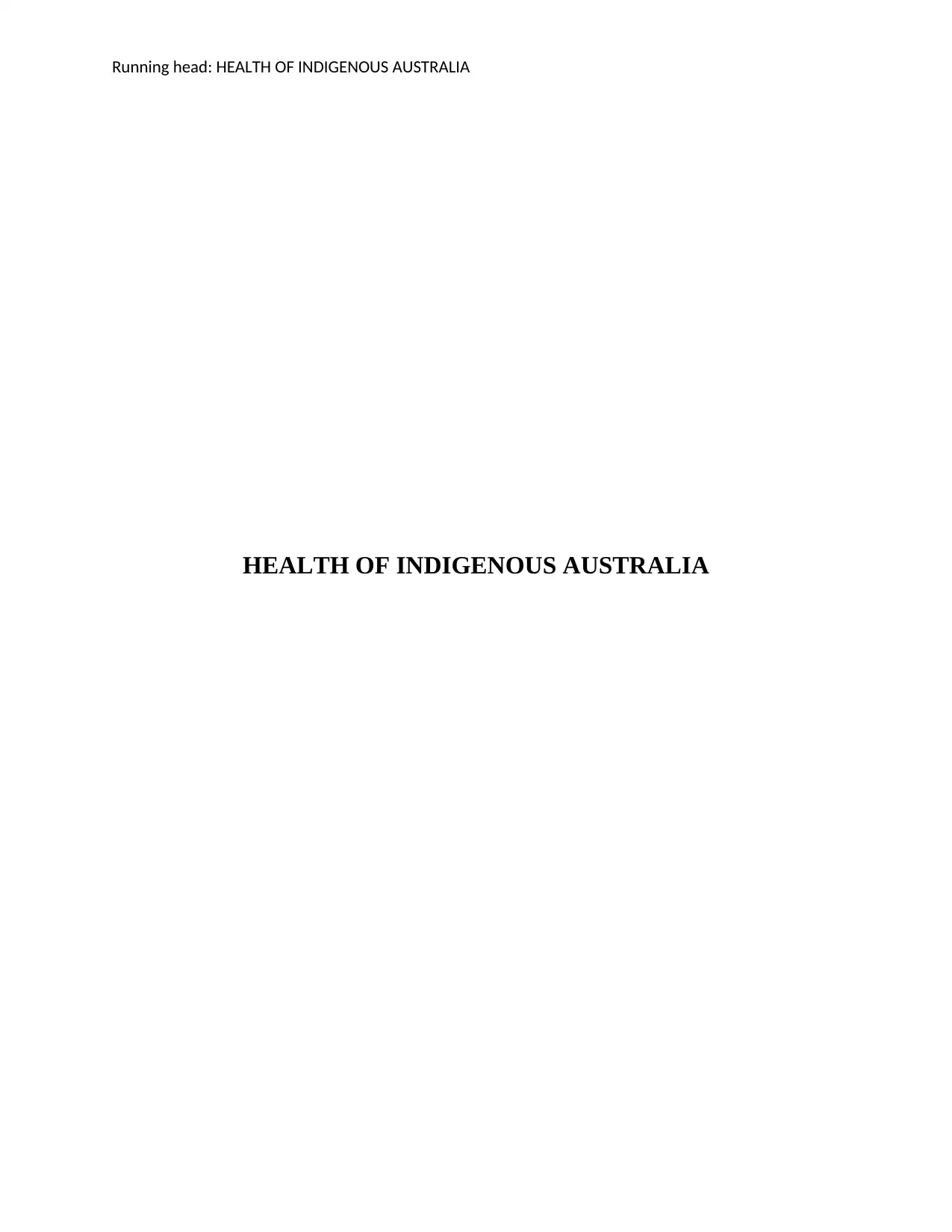
Running head: HEALTH OF INDIGENOUS AUSTRALIA
HEALTH OF INDIGENOUS AUSTRALIA
HEALTH OF INDIGENOUS AUSTRALIA
Paraphrase This Document
Need a fresh take? Get an instant paraphrase of this document with our AI Paraphraser
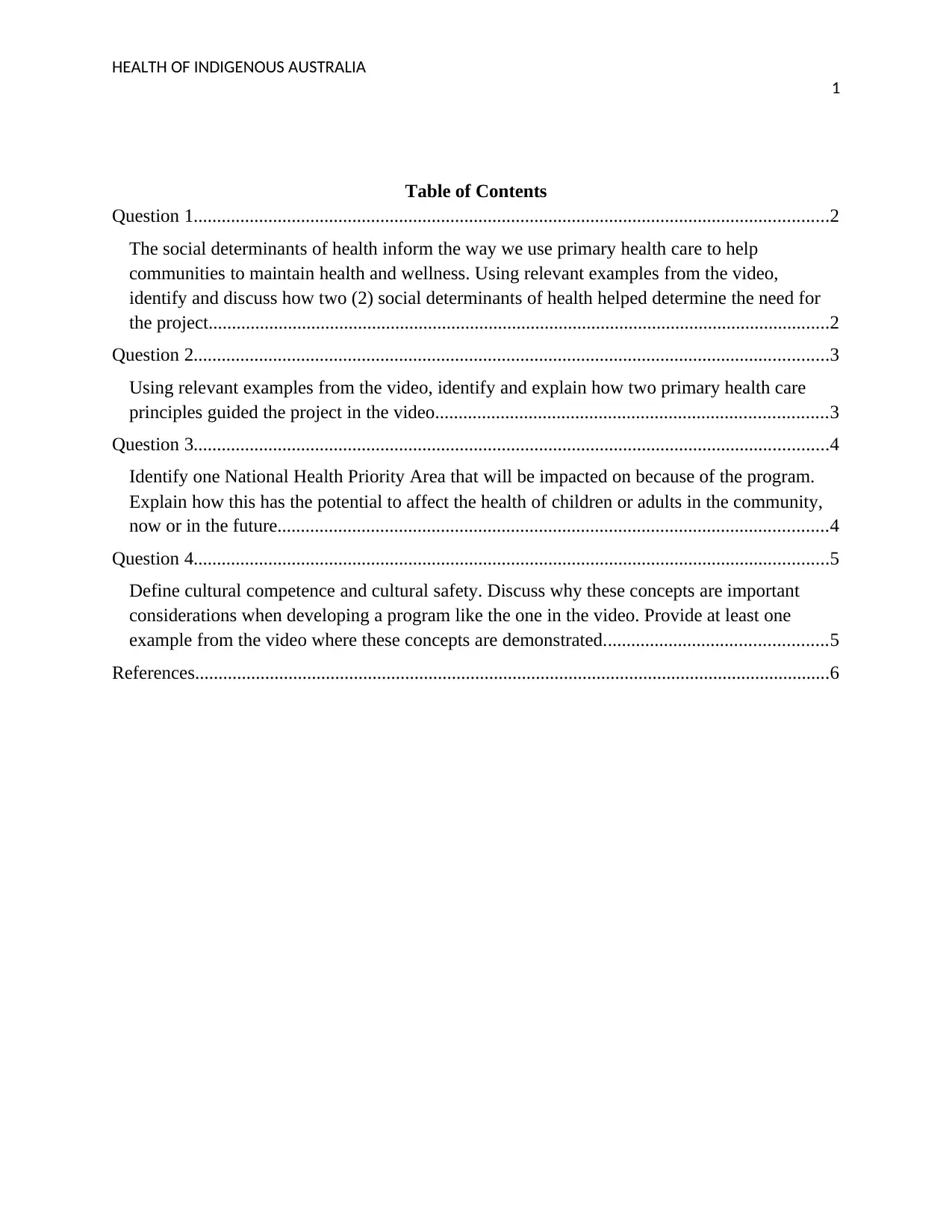
HEALTH OF INDIGENOUS AUSTRALIA
1
Table of Contents
Question 1........................................................................................................................................2
The social determinants of health inform the way we use primary health care to help
communities to maintain health and wellness. Using relevant examples from the video,
identify and discuss how two (2) social determinants of health helped determine the need for
the project.....................................................................................................................................2
Question 2........................................................................................................................................3
Using relevant examples from the video, identify and explain how two primary health care
principles guided the project in the video....................................................................................3
Question 3........................................................................................................................................4
Identify one National Health Priority Area that will be impacted on because of the program.
Explain how this has the potential to affect the health of children or adults in the community,
now or in the future......................................................................................................................4
Question 4........................................................................................................................................5
Define cultural competence and cultural safety. Discuss why these concepts are important
considerations when developing a program like the one in the video. Provide at least one
example from the video where these concepts are demonstrated................................................5
References........................................................................................................................................6
1
Table of Contents
Question 1........................................................................................................................................2
The social determinants of health inform the way we use primary health care to help
communities to maintain health and wellness. Using relevant examples from the video,
identify and discuss how two (2) social determinants of health helped determine the need for
the project.....................................................................................................................................2
Question 2........................................................................................................................................3
Using relevant examples from the video, identify and explain how two primary health care
principles guided the project in the video....................................................................................3
Question 3........................................................................................................................................4
Identify one National Health Priority Area that will be impacted on because of the program.
Explain how this has the potential to affect the health of children or adults in the community,
now or in the future......................................................................................................................4
Question 4........................................................................................................................................5
Define cultural competence and cultural safety. Discuss why these concepts are important
considerations when developing a program like the one in the video. Provide at least one
example from the video where these concepts are demonstrated................................................5
References........................................................................................................................................6
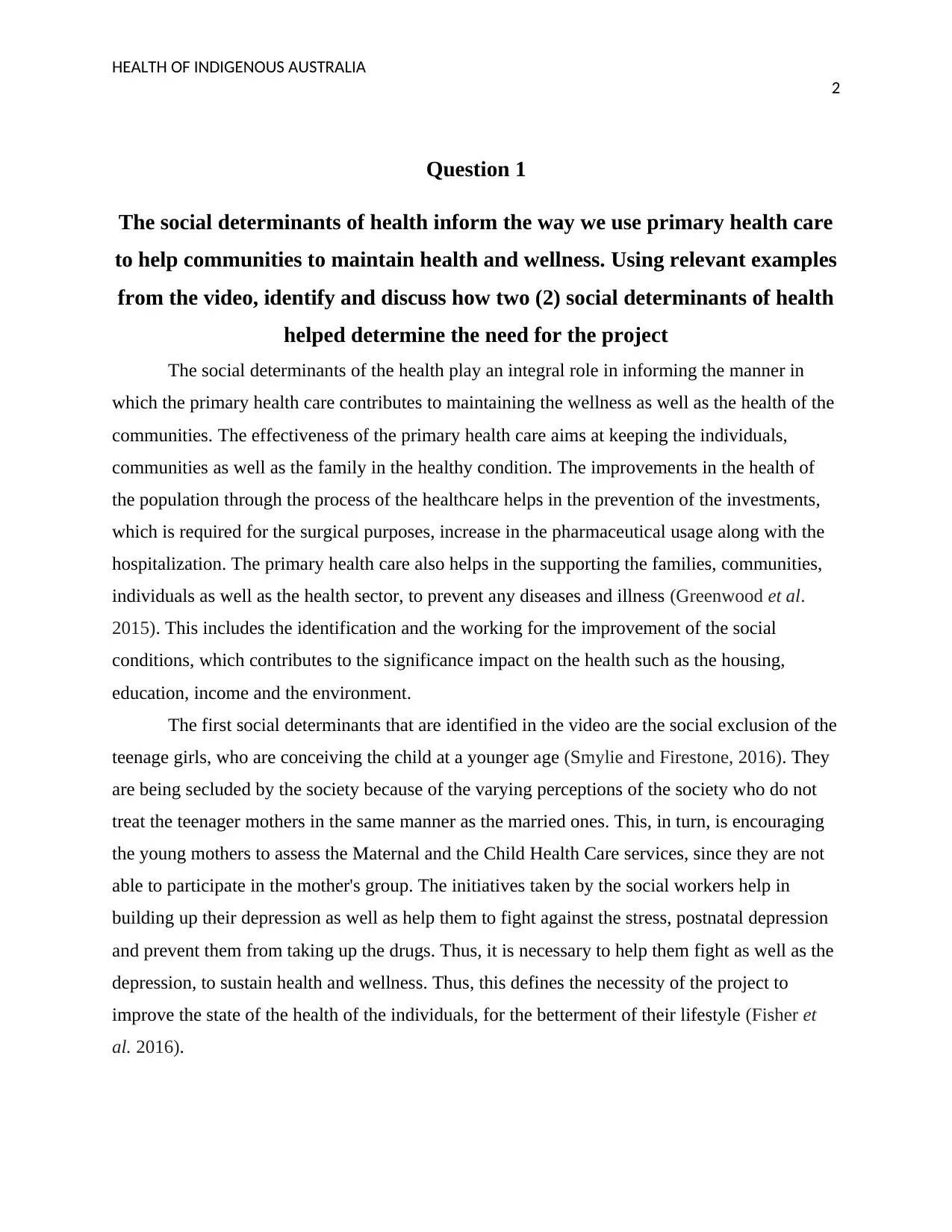
HEALTH OF INDIGENOUS AUSTRALIA
2
Question 1
The social determinants of health inform the way we use primary health care
to help communities to maintain health and wellness. Using relevant examples
from the video, identify and discuss how two (2) social determinants of health
helped determine the need for the project
The social determinants of the health play an integral role in informing the manner in
which the primary health care contributes to maintaining the wellness as well as the health of the
communities. The effectiveness of the primary health care aims at keeping the individuals,
communities as well as the family in the healthy condition. The improvements in the health of
the population through the process of the healthcare helps in the prevention of the investments,
which is required for the surgical purposes, increase in the pharmaceutical usage along with the
hospitalization. The primary health care also helps in the supporting the families, communities,
individuals as well as the health sector, to prevent any diseases and illness (Greenwood et al.
2015). This includes the identification and the working for the improvement of the social
conditions, which contributes to the significance impact on the health such as the housing,
education, income and the environment.
The first social determinants that are identified in the video are the social exclusion of the
teenage girls, who are conceiving the child at a younger age (Smylie and Firestone, 2016). They
are being secluded by the society because of the varying perceptions of the society who do not
treat the teenager mothers in the same manner as the married ones. This, in turn, is encouraging
the young mothers to assess the Maternal and the Child Health Care services, since they are not
able to participate in the mother's group. The initiatives taken by the social workers help in
building up their depression as well as help them to fight against the stress, postnatal depression
and prevent them from taking up the drugs. Thus, it is necessary to help them fight as well as the
depression, to sustain health and wellness. Thus, this defines the necessity of the project to
improve the state of the health of the individuals, for the betterment of their lifestyle (Fisher et
al. 2016).
2
Question 1
The social determinants of health inform the way we use primary health care
to help communities to maintain health and wellness. Using relevant examples
from the video, identify and discuss how two (2) social determinants of health
helped determine the need for the project
The social determinants of the health play an integral role in informing the manner in
which the primary health care contributes to maintaining the wellness as well as the health of the
communities. The effectiveness of the primary health care aims at keeping the individuals,
communities as well as the family in the healthy condition. The improvements in the health of
the population through the process of the healthcare helps in the prevention of the investments,
which is required for the surgical purposes, increase in the pharmaceutical usage along with the
hospitalization. The primary health care also helps in the supporting the families, communities,
individuals as well as the health sector, to prevent any diseases and illness (Greenwood et al.
2015). This includes the identification and the working for the improvement of the social
conditions, which contributes to the significance impact on the health such as the housing,
education, income and the environment.
The first social determinants that are identified in the video are the social exclusion of the
teenage girls, who are conceiving the child at a younger age (Smylie and Firestone, 2016). They
are being secluded by the society because of the varying perceptions of the society who do not
treat the teenager mothers in the same manner as the married ones. This, in turn, is encouraging
the young mothers to assess the Maternal and the Child Health Care services, since they are not
able to participate in the mother's group. The initiatives taken by the social workers help in
building up their depression as well as help them to fight against the stress, postnatal depression
and prevent them from taking up the drugs. Thus, it is necessary to help them fight as well as the
depression, to sustain health and wellness. Thus, this defines the necessity of the project to
improve the state of the health of the individuals, for the betterment of their lifestyle (Fisher et
al. 2016).
⊘ This is a preview!⊘
Do you want full access?
Subscribe today to unlock all pages.

Trusted by 1+ million students worldwide
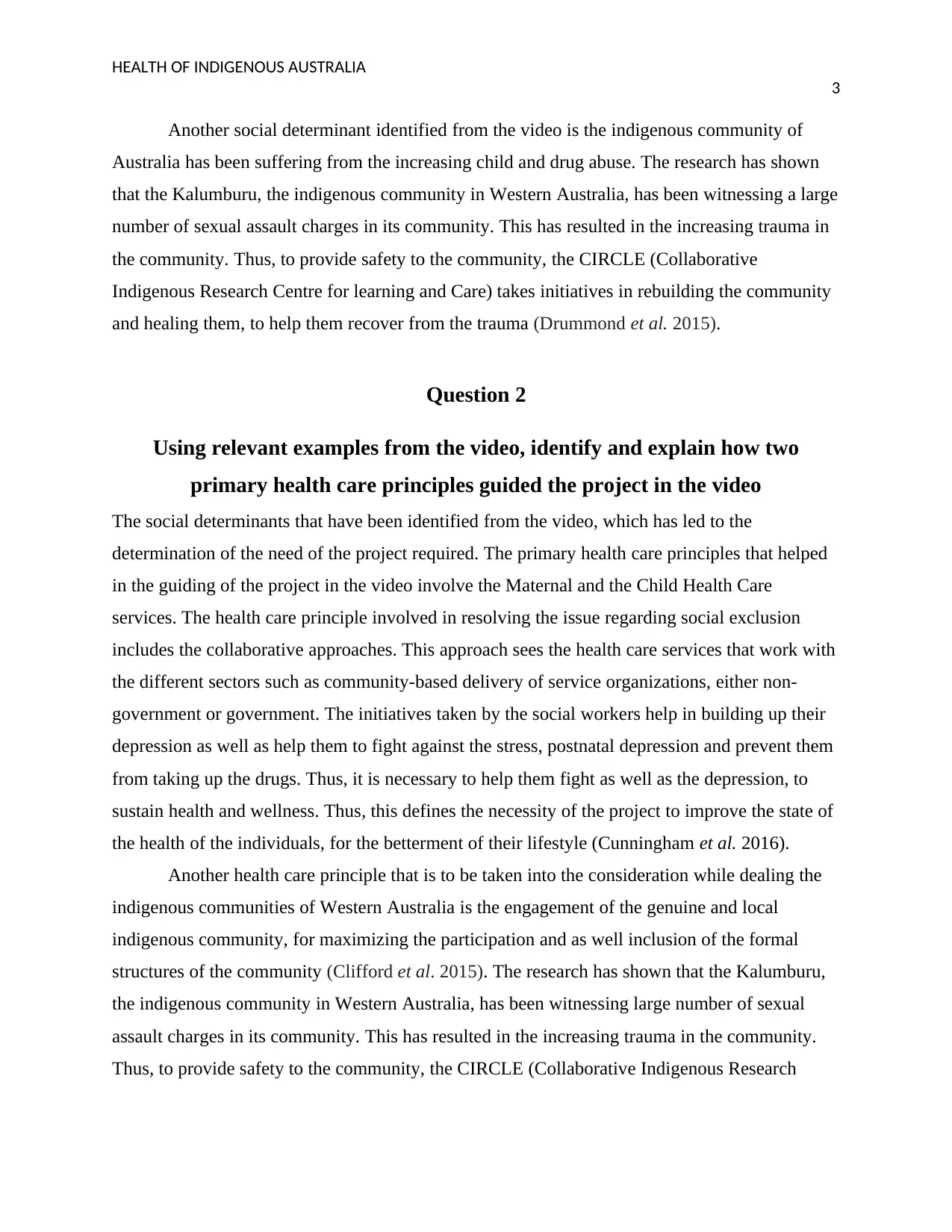
HEALTH OF INDIGENOUS AUSTRALIA
3
Another social determinant identified from the video is the indigenous community of
Australia has been suffering from the increasing child and drug abuse. The research has shown
that the Kalumburu, the indigenous community in Western Australia, has been witnessing a large
number of sexual assault charges in its community. This has resulted in the increasing trauma in
the community. Thus, to provide safety to the community, the CIRCLE (Collaborative
Indigenous Research Centre for learning and Care) takes initiatives in rebuilding the community
and healing them, to help them recover from the trauma (Drummond et al. 2015).
Question 2
Using relevant examples from the video, identify and explain how two
primary health care principles guided the project in the video
The social determinants that have been identified from the video, which has led to the
determination of the need of the project required. The primary health care principles that helped
in the guiding of the project in the video involve the Maternal and the Child Health Care
services. The health care principle involved in resolving the issue regarding social exclusion
includes the collaborative approaches. This approach sees the health care services that work with
the different sectors such as community-based delivery of service organizations, either non-
government or government. The initiatives taken by the social workers help in building up their
depression as well as help them to fight against the stress, postnatal depression and prevent them
from taking up the drugs. Thus, it is necessary to help them fight as well as the depression, to
sustain health and wellness. Thus, this defines the necessity of the project to improve the state of
the health of the individuals, for the betterment of their lifestyle (Cunningham et al. 2016).
Another health care principle that is to be taken into the consideration while dealing the
indigenous communities of Western Australia is the engagement of the genuine and local
indigenous community, for maximizing the participation and as well inclusion of the formal
structures of the community (Clifford et al. 2015). The research has shown that the Kalumburu,
the indigenous community in Western Australia, has been witnessing large number of sexual
assault charges in its community. This has resulted in the increasing trauma in the community.
Thus, to provide safety to the community, the CIRCLE (Collaborative Indigenous Research
3
Another social determinant identified from the video is the indigenous community of
Australia has been suffering from the increasing child and drug abuse. The research has shown
that the Kalumburu, the indigenous community in Western Australia, has been witnessing a large
number of sexual assault charges in its community. This has resulted in the increasing trauma in
the community. Thus, to provide safety to the community, the CIRCLE (Collaborative
Indigenous Research Centre for learning and Care) takes initiatives in rebuilding the community
and healing them, to help them recover from the trauma (Drummond et al. 2015).
Question 2
Using relevant examples from the video, identify and explain how two
primary health care principles guided the project in the video
The social determinants that have been identified from the video, which has led to the
determination of the need of the project required. The primary health care principles that helped
in the guiding of the project in the video involve the Maternal and the Child Health Care
services. The health care principle involved in resolving the issue regarding social exclusion
includes the collaborative approaches. This approach sees the health care services that work with
the different sectors such as community-based delivery of service organizations, either non-
government or government. The initiatives taken by the social workers help in building up their
depression as well as help them to fight against the stress, postnatal depression and prevent them
from taking up the drugs. Thus, it is necessary to help them fight as well as the depression, to
sustain health and wellness. Thus, this defines the necessity of the project to improve the state of
the health of the individuals, for the betterment of their lifestyle (Cunningham et al. 2016).
Another health care principle that is to be taken into the consideration while dealing the
indigenous communities of Western Australia is the engagement of the genuine and local
indigenous community, for maximizing the participation and as well inclusion of the formal
structures of the community (Clifford et al. 2015). The research has shown that the Kalumburu,
the indigenous community in Western Australia, has been witnessing large number of sexual
assault charges in its community. This has resulted in the increasing trauma in the community.
Thus, to provide safety to the community, the CIRCLE (Collaborative Indigenous Research
Paraphrase This Document
Need a fresh take? Get an instant paraphrase of this document with our AI Paraphraser
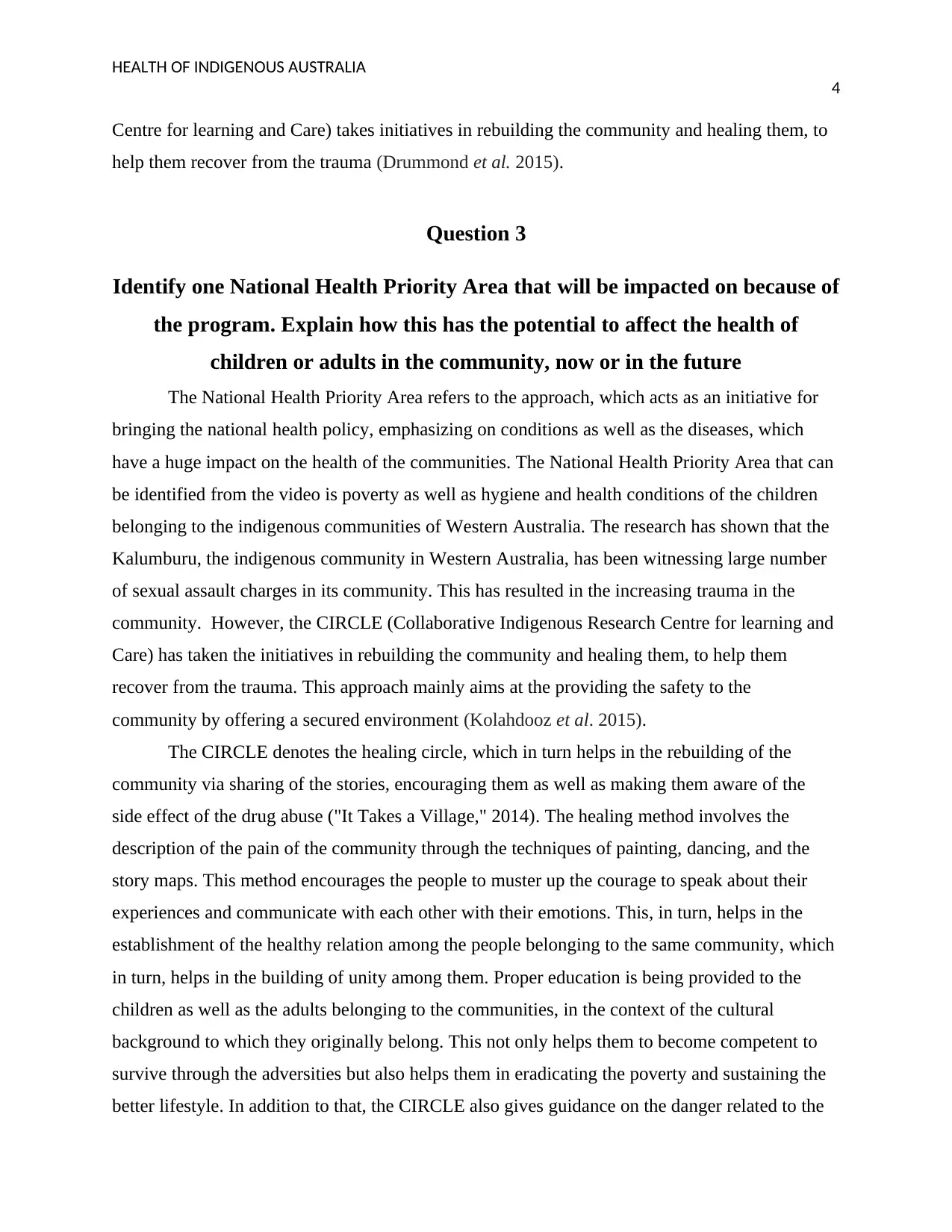
HEALTH OF INDIGENOUS AUSTRALIA
4
Centre for learning and Care) takes initiatives in rebuilding the community and healing them, to
help them recover from the trauma (Drummond et al. 2015).
Question 3
Identify one National Health Priority Area that will be impacted on because of
the program. Explain how this has the potential to affect the health of
children or adults in the community, now or in the future
The National Health Priority Area refers to the approach, which acts as an initiative for
bringing the national health policy, emphasizing on conditions as well as the diseases, which
have a huge impact on the health of the communities. The National Health Priority Area that can
be identified from the video is poverty as well as hygiene and health conditions of the children
belonging to the indigenous communities of Western Australia. The research has shown that the
Kalumburu, the indigenous community in Western Australia, has been witnessing large number
of sexual assault charges in its community. This has resulted in the increasing trauma in the
community. However, the CIRCLE (Collaborative Indigenous Research Centre for learning and
Care) has taken the initiatives in rebuilding the community and healing them, to help them
recover from the trauma. This approach mainly aims at the providing the safety to the
community by offering a secured environment (Kolahdooz et al. 2015).
The CIRCLE denotes the healing circle, which in turn helps in the rebuilding of the
community via sharing of the stories, encouraging them as well as making them aware of the
side effect of the drug abuse ("It Takes a Village," 2014). The healing method involves the
description of the pain of the community through the techniques of painting, dancing, and the
story maps. This method encourages the people to muster up the courage to speak about their
experiences and communicate with each other with their emotions. This, in turn, helps in the
establishment of the healthy relation among the people belonging to the same community, which
in turn, helps in the building of unity among them. Proper education is being provided to the
children as well as the adults belonging to the communities, in the context of the cultural
background to which they originally belong. This not only helps them to become competent to
survive through the adversities but also helps them in eradicating the poverty and sustaining the
better lifestyle. In addition to that, the CIRCLE also gives guidance on the danger related to the
4
Centre for learning and Care) takes initiatives in rebuilding the community and healing them, to
help them recover from the trauma (Drummond et al. 2015).
Question 3
Identify one National Health Priority Area that will be impacted on because of
the program. Explain how this has the potential to affect the health of
children or adults in the community, now or in the future
The National Health Priority Area refers to the approach, which acts as an initiative for
bringing the national health policy, emphasizing on conditions as well as the diseases, which
have a huge impact on the health of the communities. The National Health Priority Area that can
be identified from the video is poverty as well as hygiene and health conditions of the children
belonging to the indigenous communities of Western Australia. The research has shown that the
Kalumburu, the indigenous community in Western Australia, has been witnessing large number
of sexual assault charges in its community. This has resulted in the increasing trauma in the
community. However, the CIRCLE (Collaborative Indigenous Research Centre for learning and
Care) has taken the initiatives in rebuilding the community and healing them, to help them
recover from the trauma. This approach mainly aims at the providing the safety to the
community by offering a secured environment (Kolahdooz et al. 2015).
The CIRCLE denotes the healing circle, which in turn helps in the rebuilding of the
community via sharing of the stories, encouraging them as well as making them aware of the
side effect of the drug abuse ("It Takes a Village," 2014). The healing method involves the
description of the pain of the community through the techniques of painting, dancing, and the
story maps. This method encourages the people to muster up the courage to speak about their
experiences and communicate with each other with their emotions. This, in turn, helps in the
establishment of the healthy relation among the people belonging to the same community, which
in turn, helps in the building of unity among them. Proper education is being provided to the
children as well as the adults belonging to the communities, in the context of the cultural
background to which they originally belong. This not only helps them to become competent to
survive through the adversities but also helps them in eradicating the poverty and sustaining the
better lifestyle. In addition to that, the CIRCLE also gives guidance on the danger related to the
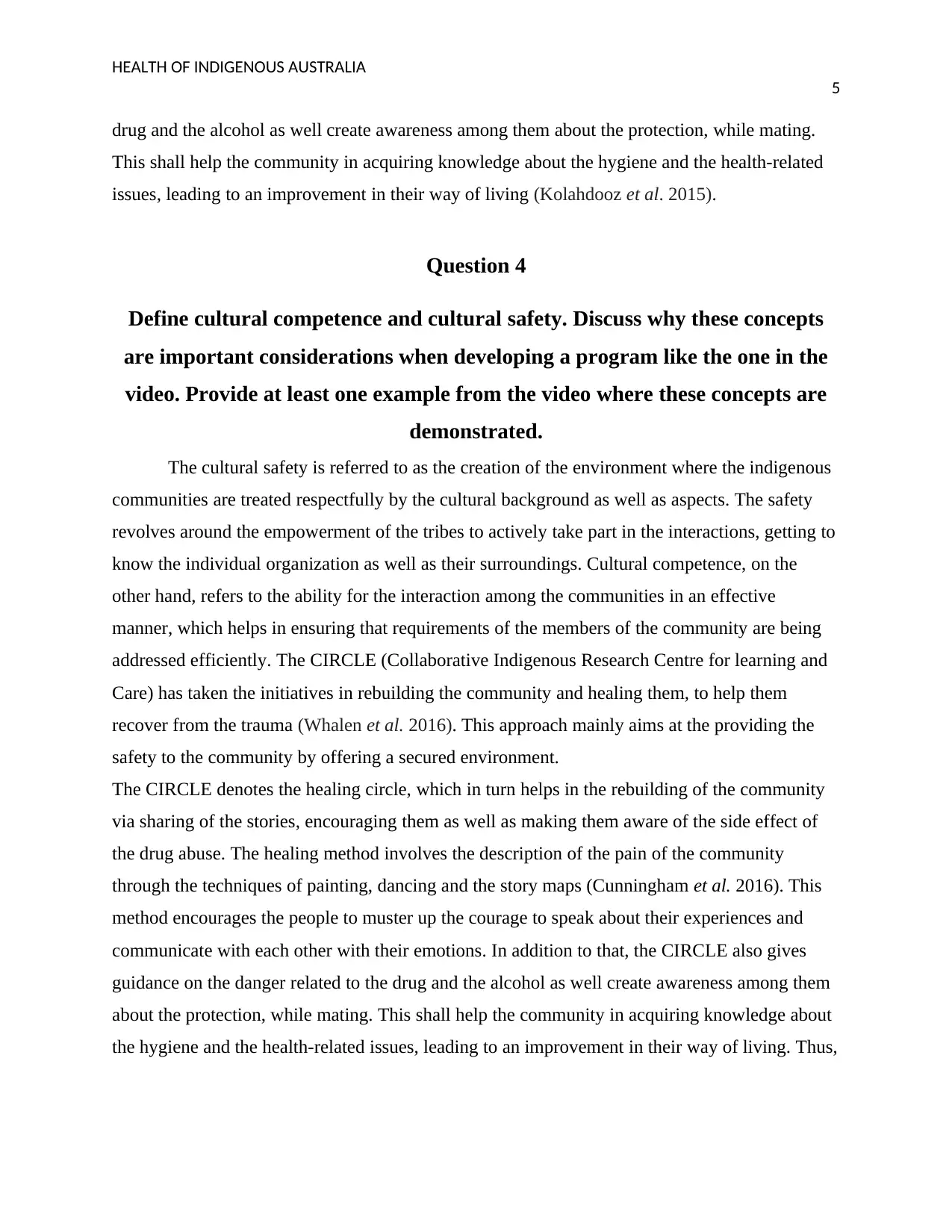
HEALTH OF INDIGENOUS AUSTRALIA
5
drug and the alcohol as well create awareness among them about the protection, while mating.
This shall help the community in acquiring knowledge about the hygiene and the health-related
issues, leading to an improvement in their way of living (Kolahdooz et al. 2015).
Question 4
Define cultural competence and cultural safety. Discuss why these concepts
are important considerations when developing a program like the one in the
video. Provide at least one example from the video where these concepts are
demonstrated.
The cultural safety is referred to as the creation of the environment where the indigenous
communities are treated respectfully by the cultural background as well as aspects. The safety
revolves around the empowerment of the tribes to actively take part in the interactions, getting to
know the individual organization as well as their surroundings. Cultural competence, on the
other hand, refers to the ability for the interaction among the communities in an effective
manner, which helps in ensuring that requirements of the members of the community are being
addressed efficiently. The CIRCLE (Collaborative Indigenous Research Centre for learning and
Care) has taken the initiatives in rebuilding the community and healing them, to help them
recover from the trauma (Whalen et al. 2016). This approach mainly aims at the providing the
safety to the community by offering a secured environment.
The CIRCLE denotes the healing circle, which in turn helps in the rebuilding of the community
via sharing of the stories, encouraging them as well as making them aware of the side effect of
the drug abuse. The healing method involves the description of the pain of the community
through the techniques of painting, dancing and the story maps (Cunningham et al. 2016). This
method encourages the people to muster up the courage to speak about their experiences and
communicate with each other with their emotions. In addition to that, the CIRCLE also gives
guidance on the danger related to the drug and the alcohol as well create awareness among them
about the protection, while mating. This shall help the community in acquiring knowledge about
the hygiene and the health-related issues, leading to an improvement in their way of living. Thus,
5
drug and the alcohol as well create awareness among them about the protection, while mating.
This shall help the community in acquiring knowledge about the hygiene and the health-related
issues, leading to an improvement in their way of living (Kolahdooz et al. 2015).
Question 4
Define cultural competence and cultural safety. Discuss why these concepts
are important considerations when developing a program like the one in the
video. Provide at least one example from the video where these concepts are
demonstrated.
The cultural safety is referred to as the creation of the environment where the indigenous
communities are treated respectfully by the cultural background as well as aspects. The safety
revolves around the empowerment of the tribes to actively take part in the interactions, getting to
know the individual organization as well as their surroundings. Cultural competence, on the
other hand, refers to the ability for the interaction among the communities in an effective
manner, which helps in ensuring that requirements of the members of the community are being
addressed efficiently. The CIRCLE (Collaborative Indigenous Research Centre for learning and
Care) has taken the initiatives in rebuilding the community and healing them, to help them
recover from the trauma (Whalen et al. 2016). This approach mainly aims at the providing the
safety to the community by offering a secured environment.
The CIRCLE denotes the healing circle, which in turn helps in the rebuilding of the community
via sharing of the stories, encouraging them as well as making them aware of the side effect of
the drug abuse. The healing method involves the description of the pain of the community
through the techniques of painting, dancing and the story maps (Cunningham et al. 2016). This
method encourages the people to muster up the courage to speak about their experiences and
communicate with each other with their emotions. In addition to that, the CIRCLE also gives
guidance on the danger related to the drug and the alcohol as well create awareness among them
about the protection, while mating. This shall help the community in acquiring knowledge about
the hygiene and the health-related issues, leading to an improvement in their way of living. Thus,
⊘ This is a preview!⊘
Do you want full access?
Subscribe today to unlock all pages.

Trusted by 1+ million students worldwide
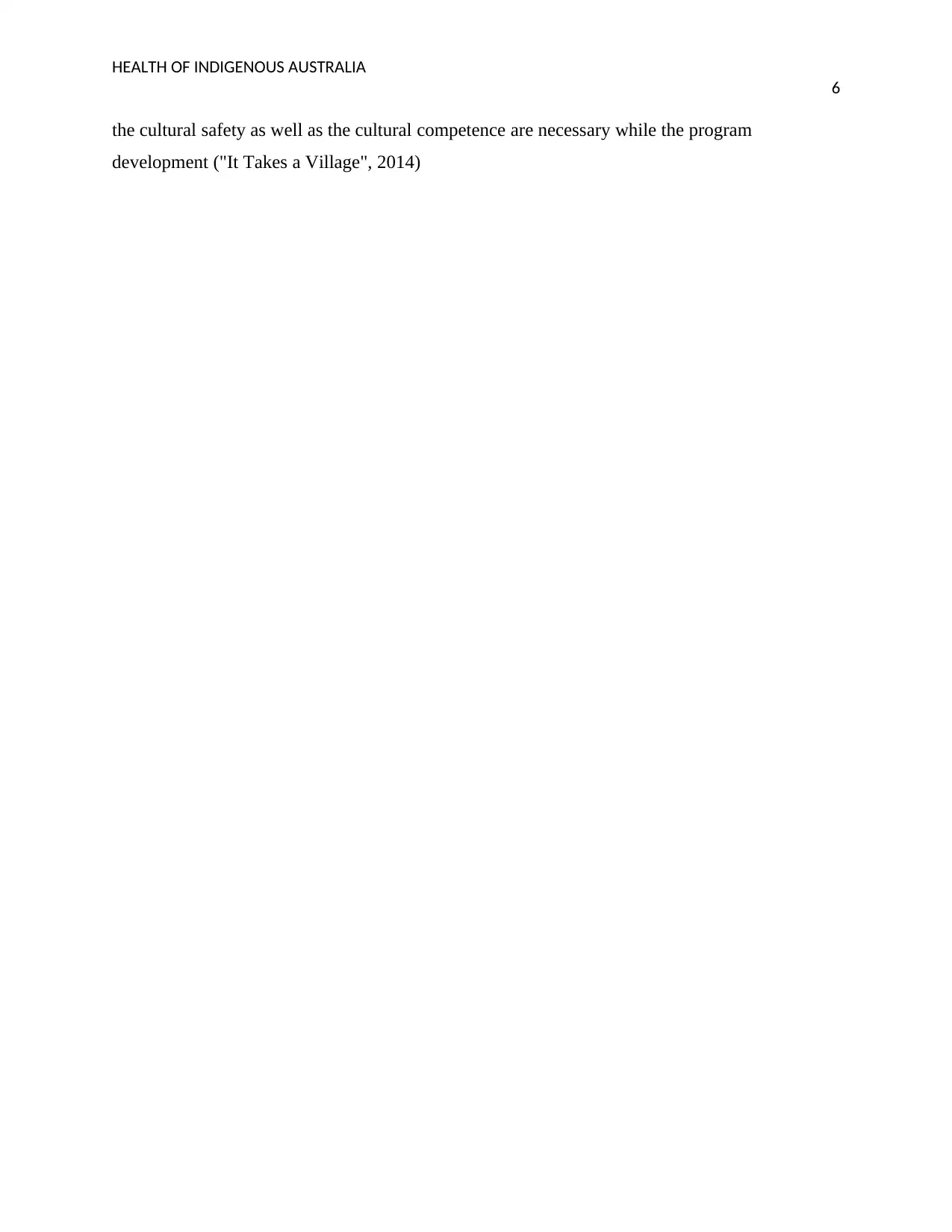
HEALTH OF INDIGENOUS AUSTRALIA
6
the cultural safety as well as the cultural competence are necessary while the program
development ("It Takes a Village", 2014)
6
the cultural safety as well as the cultural competence are necessary while the program
development ("It Takes a Village", 2014)
Paraphrase This Document
Need a fresh take? Get an instant paraphrase of this document with our AI Paraphraser
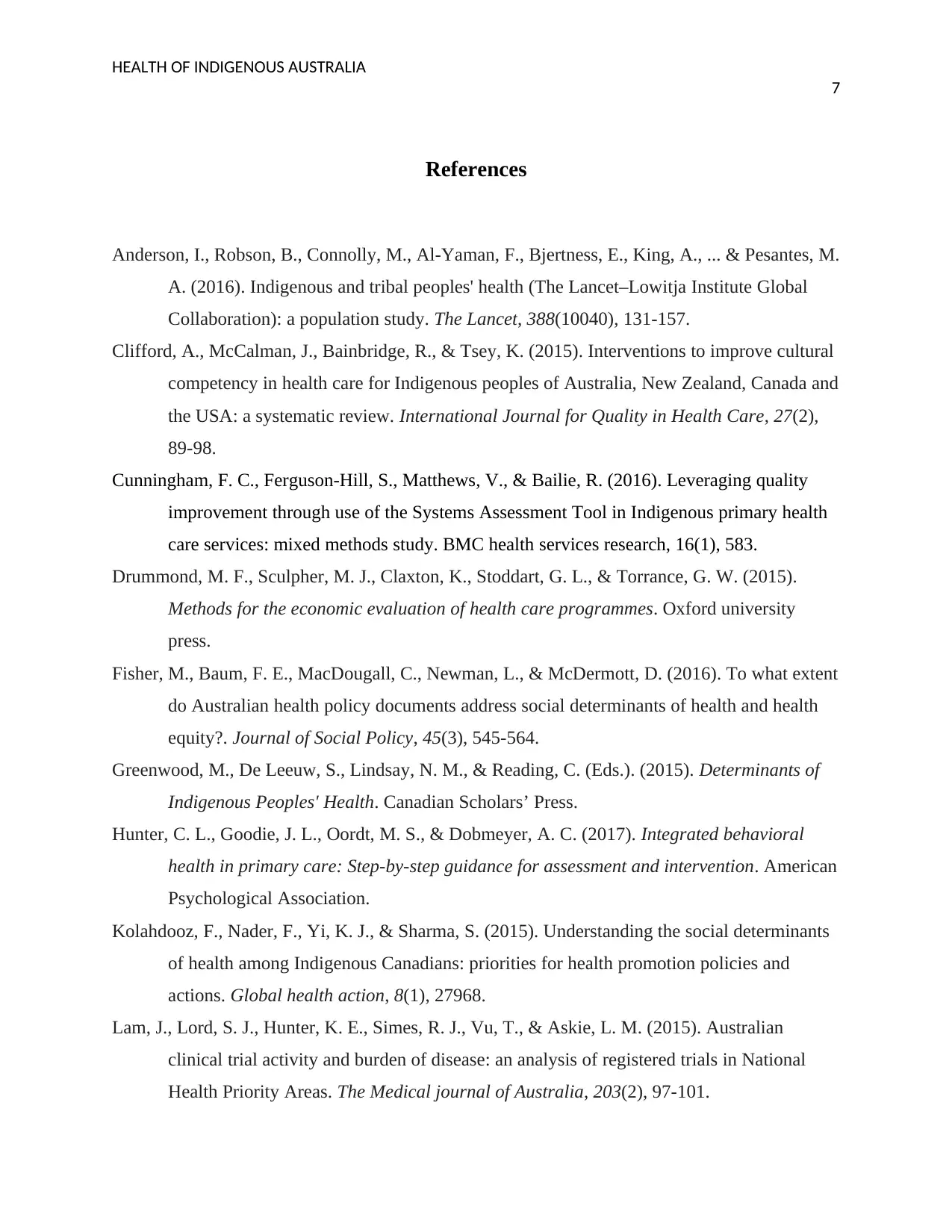
HEALTH OF INDIGENOUS AUSTRALIA
7
References
Anderson, I., Robson, B., Connolly, M., Al-Yaman, F., Bjertness, E., King, A., ... & Pesantes, M.
A. (2016). Indigenous and tribal peoples' health (The Lancet–Lowitja Institute Global
Collaboration): a population study. The Lancet, 388(10040), 131-157.
Clifford, A., McCalman, J., Bainbridge, R., & Tsey, K. (2015). Interventions to improve cultural
competency in health care for Indigenous peoples of Australia, New Zealand, Canada and
the USA: a systematic review. International Journal for Quality in Health Care, 27(2),
89-98.
Cunningham, F. C., Ferguson-Hill, S., Matthews, V., & Bailie, R. (2016). Leveraging quality
improvement through use of the Systems Assessment Tool in Indigenous primary health
care services: mixed methods study. BMC health services research, 16(1), 583.
Drummond, M. F., Sculpher, M. J., Claxton, K., Stoddart, G. L., & Torrance, G. W. (2015).
Methods for the economic evaluation of health care programmes. Oxford university
press.
Fisher, M., Baum, F. E., MacDougall, C., Newman, L., & McDermott, D. (2016). To what extent
do Australian health policy documents address social determinants of health and health
equity?. Journal of Social Policy, 45(3), 545-564.
Greenwood, M., De Leeuw, S., Lindsay, N. M., & Reading, C. (Eds.). (2015). Determinants of
Indigenous Peoples' Health. Canadian Scholars’ Press.
Hunter, C. L., Goodie, J. L., Oordt, M. S., & Dobmeyer, A. C. (2017). Integrated behavioral
health in primary care: Step-by-step guidance for assessment and intervention. American
Psychological Association.
Kolahdooz, F., Nader, F., Yi, K. J., & Sharma, S. (2015). Understanding the social determinants
of health among Indigenous Canadians: priorities for health promotion policies and
actions. Global health action, 8(1), 27968.
Lam, J., Lord, S. J., Hunter, K. E., Simes, R. J., Vu, T., & Askie, L. M. (2015). Australian
clinical trial activity and burden of disease: an analysis of registered trials in National
Health Priority Areas. The Medical journal of Australia, 203(2), 97-101.
7
References
Anderson, I., Robson, B., Connolly, M., Al-Yaman, F., Bjertness, E., King, A., ... & Pesantes, M.
A. (2016). Indigenous and tribal peoples' health (The Lancet–Lowitja Institute Global
Collaboration): a population study. The Lancet, 388(10040), 131-157.
Clifford, A., McCalman, J., Bainbridge, R., & Tsey, K. (2015). Interventions to improve cultural
competency in health care for Indigenous peoples of Australia, New Zealand, Canada and
the USA: a systematic review. International Journal for Quality in Health Care, 27(2),
89-98.
Cunningham, F. C., Ferguson-Hill, S., Matthews, V., & Bailie, R. (2016). Leveraging quality
improvement through use of the Systems Assessment Tool in Indigenous primary health
care services: mixed methods study. BMC health services research, 16(1), 583.
Drummond, M. F., Sculpher, M. J., Claxton, K., Stoddart, G. L., & Torrance, G. W. (2015).
Methods for the economic evaluation of health care programmes. Oxford university
press.
Fisher, M., Baum, F. E., MacDougall, C., Newman, L., & McDermott, D. (2016). To what extent
do Australian health policy documents address social determinants of health and health
equity?. Journal of Social Policy, 45(3), 545-564.
Greenwood, M., De Leeuw, S., Lindsay, N. M., & Reading, C. (Eds.). (2015). Determinants of
Indigenous Peoples' Health. Canadian Scholars’ Press.
Hunter, C. L., Goodie, J. L., Oordt, M. S., & Dobmeyer, A. C. (2017). Integrated behavioral
health in primary care: Step-by-step guidance for assessment and intervention. American
Psychological Association.
Kolahdooz, F., Nader, F., Yi, K. J., & Sharma, S. (2015). Understanding the social determinants
of health among Indigenous Canadians: priorities for health promotion policies and
actions. Global health action, 8(1), 27968.
Lam, J., Lord, S. J., Hunter, K. E., Simes, R. J., Vu, T., & Askie, L. M. (2015). Australian
clinical trial activity and burden of disease: an analysis of registered trials in National
Health Priority Areas. The Medical journal of Australia, 203(2), 97-101.
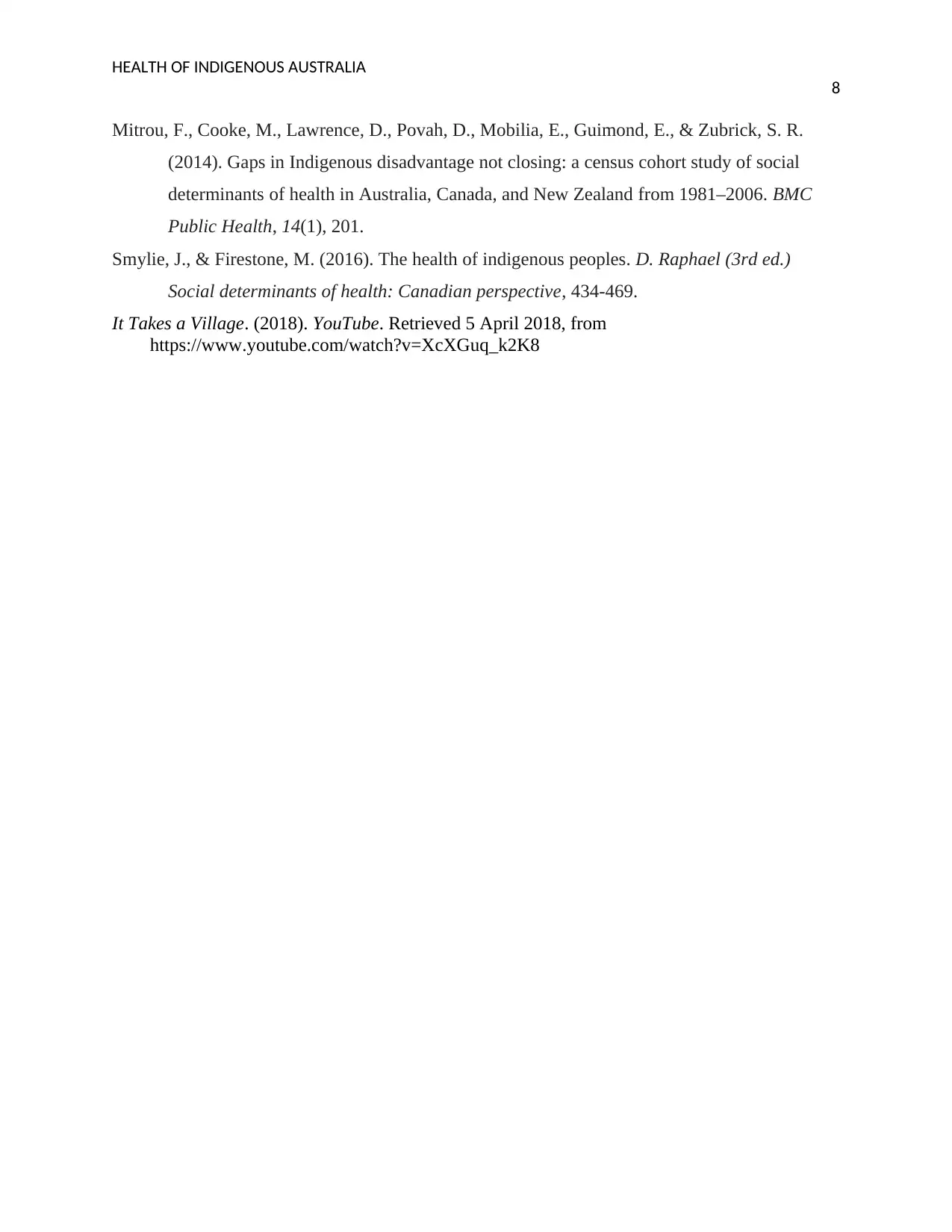
HEALTH OF INDIGENOUS AUSTRALIA
8
Mitrou, F., Cooke, M., Lawrence, D., Povah, D., Mobilia, E., Guimond, E., & Zubrick, S. R.
(2014). Gaps in Indigenous disadvantage not closing: a census cohort study of social
determinants of health in Australia, Canada, and New Zealand from 1981–2006. BMC
Public Health, 14(1), 201.
Smylie, J., & Firestone, M. (2016). The health of indigenous peoples. D. Raphael (3rd ed.)
Social determinants of health: Canadian perspective, 434-469.
It Takes a Village. (2018). YouTube. Retrieved 5 April 2018, from
https://www.youtube.com/watch?v=XcXGuq_k2K8
8
Mitrou, F., Cooke, M., Lawrence, D., Povah, D., Mobilia, E., Guimond, E., & Zubrick, S. R.
(2014). Gaps in Indigenous disadvantage not closing: a census cohort study of social
determinants of health in Australia, Canada, and New Zealand from 1981–2006. BMC
Public Health, 14(1), 201.
Smylie, J., & Firestone, M. (2016). The health of indigenous peoples. D. Raphael (3rd ed.)
Social determinants of health: Canadian perspective, 434-469.
It Takes a Village. (2018). YouTube. Retrieved 5 April 2018, from
https://www.youtube.com/watch?v=XcXGuq_k2K8
⊘ This is a preview!⊘
Do you want full access?
Subscribe today to unlock all pages.

Trusted by 1+ million students worldwide
1 out of 9
Related Documents
Your All-in-One AI-Powered Toolkit for Academic Success.
+13062052269
info@desklib.com
Available 24*7 on WhatsApp / Email
![[object Object]](/_next/static/media/star-bottom.7253800d.svg)
Unlock your academic potential
Copyright © 2020–2025 A2Z Services. All Rights Reserved. Developed and managed by ZUCOL.



